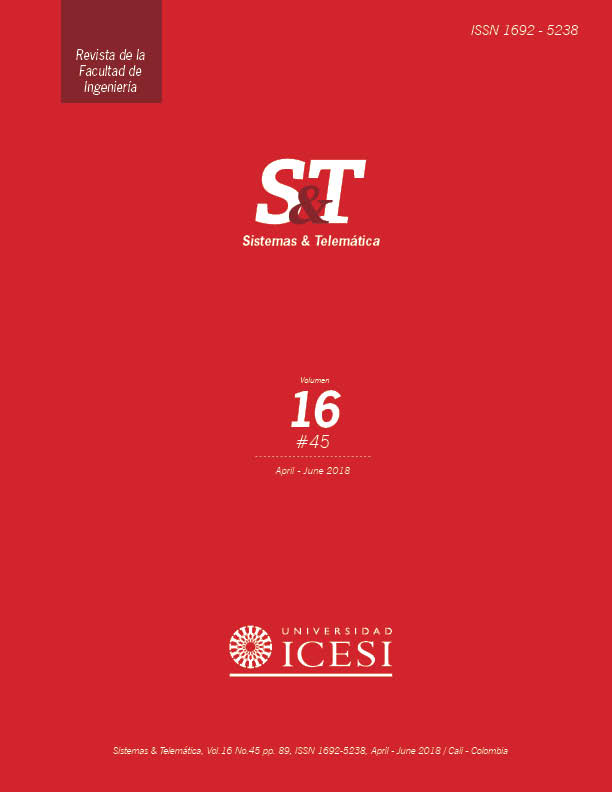Rumo a cidades mais inteligentes aproveitando o paradigma Fog Computing
DOI:
https://doi.org/10.18046/syt.v16i45.2756Palavras-chave:
Névoa computacional; computação em nuvem; cidades inteligentes.Resumo
O termo fog computing [Computação em neblina ou neblina computacional] ganhou impulso nos últimos anos devido à sua incidência na diminuição da latência que as aplicações da Internet das Coisas [IoT, Internet of Things] têm, as quais demandam respostas em tempo real ou próximo do real, bem como o menor consumo de largura de banda que resulta da resolução de parte do processamento mais próximo dos dispositivos do usuário final. O paradigma da computação em nuvem já não é suficiente. No presente, a necessidade do "dado" e de tomada de decisão instantânea, conduzem, ou de alguma forma descobrem, um novo horizonte que exige uma variante complementar. Este artigo é uma abordagem do conceito de fog computing, juntamente com a análise de sua necessidade de soluções de engenharia no campo da IoT, seu impacto em cidades inteligentes e outros campos de ação e alguns dos seus principais desafios. Ele também oferece um roteiro para implementar um sistema de recomendação de locais de interesse para o viajante com base na fog computing, no âmbito de um projeto de cidades inteligentes em Havana.
Referências
Akamai Technologies. (2017). Q1 2017 State of the Internet / Connectivity Report. Retrieved from: https://www.akamai.com/us/en/multimedia/documents/state-of-the-internet/q1-2017-state-of-the-internet-connectivity-report.pdf
Arco Research Group (2017, March 12). El papel de la tecnología de lógica reconfigurable como respuesta a los retos del Internet de las Cosas. Retrieved from: https://arcoresearchgroup.wordpress.com/2017/03/12/el-papel-de-la-tecnologia-de-logica-reconfigurable-como-respuesta-a-los-retos-del-internet-de-las-cosas/
Bojanova, I. (2015). What makes up the Internet of Things? Retrieved from: https://www.computer.org/web/sensing-iot/content?g=53926943&type=article&urlTitle=what-are-the-components-of-iot-
Bonomi,F., Milito, R., Zhu, J., & Addepalli, S. (2012). Fog computing and its role in the Internet of Things. In: Proceedings of the first edition of the MCC Workshop on Mobile Cloud Computing, (pp. 13-16). New York, NY: ACM.
Cardellini, V., Grassi, V., Lo Presti, F., Nardelli, M. (2015). On QoS-aware Scheduling of Data Stream Applications over Fog Computing Infrastructures. In: 2015 IEEE Symposium on Computers and Communication (ISCC), (pp. 271-276). doi:10.1109/ISCC.2015.7405527
Cisco Systems. (2017). Fog computing and the Internet of things: Extend the cloud to where the things are [white paper]. Retrieved from: https://www.cisco.com/c/dam/en_us/solutions/trends/iot/docs/computing-overview.pdf
De Fuenmayor, A. (2017, Feb. 20). Cloud computing, ¿el final de una era? [blog ThinkingBig]. Retrieved from: https://aunclicdelastic.blogthinkbig.com/cloud-computing-iot/
Gonzalez, G., Delgado, T., Capote, J. L., & Cruz, R. (2013). Context-aware recommender system based on ontologies. In: H. Onsrud, & A. Rajabifard (Eds.), Spatially enablement in support of economic development and poverty reduction, (pp. 227-243). Reston, VA: GSDI.
Gupta, H., Vahid-Dastjerdi, A., Ghosh, S.K., Buyya, R. (2017). FogSim: A toolkit for modeling and simulation of resource management techniques in internet of things, edge and fog computing environments. Software: Practice and Experience, 47(9), 1275-1296.
Hu, P., Dhelim, S., Ning, H. Qiu, T. (2017). Survey on fog computing: Architecture, key technologies, applications and open issues. Journal of Network and Computer Applications, 98, 27-42.
International Telecommunications Union [ITU]. (25/ 4/2017). The Manizales Manifesto. Retrieved from: https://www.itu.int/en/ITU-T/Workshops-and-Seminars/gsw/201704/Documents/Manifesto-Manizales-05-04-2017-Eng-Final.pdf
Lai, C. F., Song, D. Y., Hwang, R. H., & Lai, Y. X. (2016). A QoS-aware streaming service over fog computing infrastructures. In Digital Media Industry & Academic Forum (DMIAF), (pp. 94-98). IEEE.
Mapped: The world according to Internet connection speeds - Telegraph (2017, April, 9). Retrieved from: http://www.telegraph.co.uk/travel/maps-and-graphics/countries-with-fastest-internet-connection-speeds/
Mohamed, N., Al-Jaroodi, J., Jawhar, I., Lazarova-Molnar, S., & Mahmoud, S. (2017). Smartcityware: A service-oriented middleware for cloud and fog enabled smart city services. IEEE Acces, 5, 17576-17588. doi:r 10.1109/ACCESS.2017.2731382
Varshney, P., & Simmhan, Y. (2017). Demystifying fog computing: Characterizing architectures, applications and abstractions. In Fog and Edge Computing (ICFEC), 2017 IEEE 1st International Conference on (pp. 115-124). IEEE.
Yousefpour, A., Ishigaki, G., & Jue, J. P. (2017). Fog computing: Towards minimizing delay in the internet of things. In Edge Computing (EDGE), 2017 IEEE International Conference on (pp. 17-24). IEEE.
Downloads
Publicado
Edição
Seção
Licença
Esta publicação está licenciada sob os termos da licença CC BY 4.0 (https://creativecommons.org/licenses/by/4.0/deed.pt_BR).



